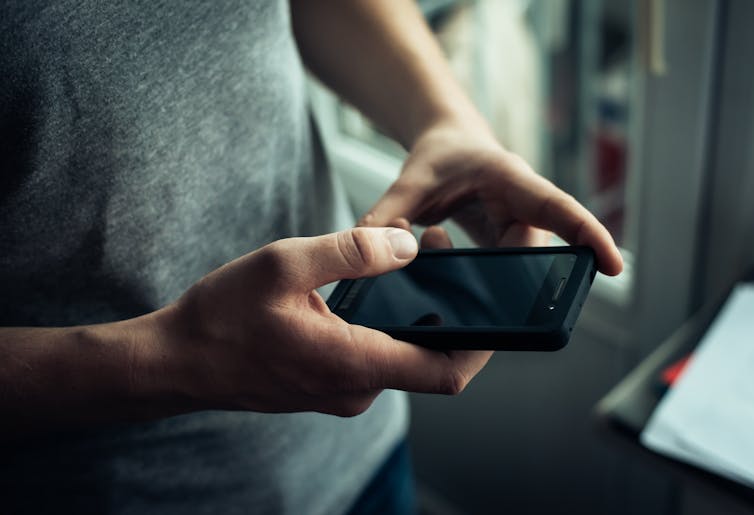
The UK government has promised that its new app, expected to launch in late 2022, will be a one-stop shop, simplifying access to a wide range of government services. But issues of surveillance and access are just some of the questions yet to be addressed.
While existing government apps are typically narrow in their function, the new gov.uk app is reportedly set to provide access to 300 government services in one place. This could mean the many interactions people have with government – think benefits, births and deaths, childcare, disability, education, employment, housing, driving, tax, passports, visas and more – would now all take place beginning with the same little icon on your smartphone.
The 300 figure is only a portion of the total services provided by the government – but the message is clear: apps are now the preferred channel for service provision. The move to “appify” public services is not surprising given how much time we already spend using apps (4.2 hours per day, according to recent research) but it’s worth reflecting on nonetheless.
While the government has said the app will be optional, with other access channels remaining available, the app needs to be understood as part of the long march towards digitisation. From the government’s perspective, digital is the most efficient (that is, the cheapest) way to interact with citizens, as compared with other channels such as telephone, post, or face-to-face.
These options may remain technically possible, but will likely be poorly resourced and burdensome to use. Earlier this year, for example, applications for driving licenses sent by post to the Driver and Vehicle Licensing Agency were taking an average of six weeks to process. Online applications were largely unaffected by these delays which were attributed to a staff walkout and social distancing requirements. The efficiency of a digital service rests upon removing humans from the equation wherever possible.
The government says the app will be easier to use than the current avenues, especially with the introduction of a single phone-based sign-in across all services. Indeed, digital services, whether packaged in an app or on the web, can be great when they’re well-designed and nothing goes wrong.
New risks
But when something does go wrong, from a faulty page to a badly designed form, we can lose hours or even days trying to get in touch with a real person. And things do go wrong. Just last week, for example, the NHS app used for COVID vaccine passports crashed, leaving passengers unable to board their flights.
If a single app becomes the default way of accessing so many government services, the possible impact of something going wrong is much higher. So along with new conveniences, the proposed app may introduce new risks, vulnerabilities and the conditions for unforeseen accidents.
Read more: Don't write off government algorithms – responsible AI can produce real benefits
As the controversies surrounding the introduction of COVID-19 contact tracing apps in the UK and beyond have highlighted, apps also pose significant threats when it comes to surveillance and privacy breaches. Apps can generate and collect detailed data about our lives, including through background processes which are difficult to detect – even for people who are well-versed in digital privacy issues.
The government says data security will be at the “heart” of the app, with users to remain “in control of their data”. But what it means to be secure and in control is not yet clear. Such issues will no doubt follow the app into production and will need to be closely monitored, especially given the recent proposal to sell NHS patient medical data.

The “appification” of government services will also do little to reduce existing digital divides. What if you don’t have a phone? What if you share a phone? What if your phone model is no longer supported? These may sound unlikely scenarios, but the government’s “EU exit” settlement scheme app was only available for iPhone models 7 and above.
Beyond issues of surveillance and access, we may ask a basic but fundamental question: what happens when a society’s main interactions with its government are reduced to an app? It’s too early to speculate too much, but two things are worth considering.
First, in app form, government services will be heavily dependent on Google and Apple, who together provide the operating systems, platforms and much of the hardware that underpin apps. This raises important questions around power and governance.
Second, if the main way we come to interact with government services is through this app, the particulars of how it’s designed will be crucial. The government’s digital services team won awards for the initial design of the GOV.UK website based on creating a clear and efficient user experience. But design is not limited to clarity and efficiency, important as these are.
Designers face the full spectrum of social challenges and should not shy away from these. Consider, for example, the Windrush Compensation Scheme which resides on gov.uk. Applications to this scheme are reported to take an average of 14 months to process, with some applicants dying before receiving compensation. Can app design play a meaningful role in improving outcomes in situations like these? If the answer is “no”, perhaps we ought to question the values driving technological innovation in government.
Privacy and security, access and divides, government-Apple-Google relations and the heightened importance of design will be four things to keep a critical eye on as the UK government moves to appify public services.
Nathaniel Tkacz does not work for, consult, own shares in or receive funding from any company or organisation that would benefit from this article, and has disclosed no relevant affiliations beyond their academic appointment.
* This article was originally published at The Conversation

0 Comments